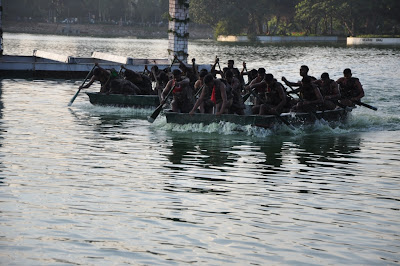ADE has conducted Nishant trials on N15-32 (28.10.2010) at Kolar Airfield in which a technology break through has been achieved. A new technology called the Structural Health Monitoring has been developed by Aeronautical Development Establishment (ADE) & National Aerospace Laboratories (NAL) for the monitoring of structural health parameters while the UAV is in flight. This break through enables the structural health of aeronautical structures to be monitored, so that online health can be monitored and online and corrective action for the flight can be taken. This enables the aircraft to be flown without unnecessarily grounding them. Analysis algorithms have been developed to predict onset of failures which would be perfected using the data obtained through today’s flight. Usage of such techniques will avoid periodic grounding of the aircraft and make the maintenance schedules to be more like “on condition maintenance”, the condition being detected even before the failure occurs. It will avoid unnecessary grounding of aircraft for inspection. Such a monitoring can be used for LCA, MCA, FGFA and other UAVs. Such techniques are going to be extensively used in the future in order to cut down the operation costs of the aircraft and can also lead to reduction in airfares. Such techniques can prevent ensuing danger of the flights by pre-warning the occurance of failure.
Friday, October 29, 2010
Nishant trials sucessful at Kolar; UAV flew with structural health monitoring tech for 2.3 hours
Labels:
ADE,
DRDO,
Nishant UAV trials
Tracking the Tejas: LSP-5 gearing-up for first flight; lit cockpit for night flying & new com set onboard; will fly on autopilot mode for first time
LCA LSP-4 during the June 2, 2010 maiden flight. LSP-5 is now gearing up for first flight. Photo: DRDO
| By Anantha Krishnan M. | AVIATION WEEK |
| By Anantha Krishnan M. | AVIATION WEEK |
Bangalore | India | October 28, 2010 |
Indian sources confirm to AVIATION WEEK that a flight readiness review meeting was held recently and the LSP-5 will fly “soon,” weather permitting. LSP-4 had its first flight in June.
“Two more high-speed taxi trials are remaining and after that we will be ready for the first flight,” says a senior official associated with the program. “It will have internal cockpit lighting for enabling night flying, with all corrections being done. We are also testing a new communication set, similar to that on the Dhruv chopper. This would again ensure commonality of inventory in the country.”
Newsbreaks will first appear on AW sites
and a gist would then be up on this blog.
and a gist would then be up on this blog.
The Inside Story: IAF sees marginal attitudinal changes in HAL; wants to get visible results on ground now
A snapshot of IAF-HAL meet at the ongoing Commanders' Conference in New Delhi. Photo: MoD
| By Anantha Krishnan M. | AVIATION WEEK |
Bangalore | India | October 28, 2010 |
The Indian Air Force (IAF) sees “marginal” positive change in defense public sector undertaking (DPSU) Hindustan Aeronautics Ltd (HAL) in terms of its commitment to delivering “quality products and sticking to the deadlines.”
A senior IAF official who is part of the ongoing IAF Commanders’ Conference in New Delhi tells AVIATION WEEK that the slight shift in HAL’s commitment was mainly due to the firm stand adopted by India’s military services.
With HAL’s quality and delivery schedules being prime concerns for the IAF for some time now, senior officials from both sides met on Oct. 26 as part of the ongoing conference to discuss fleet serviceability and delivery schedules for the current fiscal year.
“The product support has been one major area of concern and there have been very little visible results from HAL,” the official says. However, “on the ground there have been no changes in the last six months, [so] we are adopting a wait-and-watch strategy, considering the slight signs of progress.”
Sunday, October 24, 2010
Saturday, October 23, 2010
'Simple' Srinivasan is HAL's HR head; former chopper complex chief gets a peaceful, but crucial posting
HAL's new HR Director R. Srinivasan. He was earlier MD Helicopter Complex and also GM of Aerospace Division. He is now left with under 8 months to restore some order to HAL's depleting HR department.
| By Anantha Krishnan M. | AVIATION WEEK |
Bangalore | India | October 22, 2010 |
Finally, an HR head for Hindustan Aeronautics Ltd! This after the former HR director (S. Sahi) quit in a huff in April 2010 to join a private firm, without getting the mandatory clearance from Ministry of Defense (MoD), then. The post was lying vacant ever since. Insiders say that the former chopper complex chief R. Srinivasan will have a Herculean task ahead of him to set the house in order, considering the mess HAL's HR is in now.
For the full story, please visit the Aviation Week link below:
Finally, an HR head for Hindustan Aeronautics Ltd! This after the former HR director (S. Sahi) quit in a huff in April 2010 to join a private firm, without getting the mandatory clearance from Ministry of Defense (MoD), then. The post was lying vacant ever since. Insiders say that the former chopper complex chief R. Srinivasan will have a Herculean task ahead of him to set the house in order, considering the mess HAL's HR is in now.

Tuesday, October 19, 2010
Kalam@79: Cakes for cops, gyan for friends and blessings for the Billion!
Kalam@79 Photos: Saju Bhaskar, Mathrubhumi
Copyright@Tarmak007
Rustom-1 was a dream flight: DRDO
Snapshots of Rustom-1 maiden flight from TAAL, Hosur: Photos: DRDO
| By Anantha Krishnan M. | AVIATION WEEK |
Bangalore | India | October 18, 2010 |
India has flown the homegrown Rustom-1 unmanned aerial vehicle for the first time.
Developed by the Defense Research Development Organization’s (DRDO) Aeronautical Development Establishment (ADE), the 30-min. flight took place Oct. 16 from a Taneja Aerospace and Aviation Ltd. airfield at Housr, near Bangalore.“Notwithstanding erratic weather conditions, the UAV had a perfect textbook flight, meeting all mission parameters,” says Dr. Prahlada, chief controller at DRDO. “It had an autonomous taxiing, takeoff, flight and landing. It flew to a planned altitude of 3,000 feet.” Rustom-1 was commanded from the ground control station by Lt. Col. V.S. Thapa, an Indian army UAV operator.
“It was a dream flight, and we couldn’t have asked for more on its maiden outing,” ADE Director P.S. Krishnan says. “The flight demonstration has given us the confidence to try different parameters next time.”

For the previous post on Rustom-1 maiden flight, visit:
Sunday, October 17, 2010
India to launch dedicated military satellites
| By Anantha Krishnan M. | AVIATION WEEK |
Hyderabad | India | October 11, 2010 |
India plans to loft a series of dedicated satellites for defense purposes in the coming years, boosting the country’s capability to scan multiple activities on and across its borders.
“We are looking at launching one or two satellites every year to fulfill the requirements of all three military formations,” says V.K. Saraswat, chief of India’s Defense Research and Development Organization.
Although the Indian press has been reporting on the nation’s milsat plans, this is probably the first time that an official confirmation with details has been given. These satellites will have payloads for surveillance, imaging, navigation and communication.
“Once these satellites are operational, we will be able to see troop movements along the borders,” Saraswat says.

Labels:
Dr Vijay Kumar Saraswat,
DRDO Chief,
Spy Satellites
ANC key to checkmate China strategy
| By Anantha Krishnan M. | AVIATION WEEK |
Port Blair | India | October 8, 2010 |
India’s Tri-Service Command is gradually increasing its assets in order to monitor Chinese strategy in the region.
The command is situated in Andaman and Car Nicobar Islands with Port Blair as its headquarters. Officials from the Andaman Nicobar Command (ANC), confirmed that India is keeping a close watch on the activities of China and other countries in the region.
Though the officials stuck to a pre-planned brief on the sensitive China queries, it was clear the strategically located ANC keeps its antennas up round-the-clock to ensure that the region is well-guarded against external challenges.
”We are looking at developing assets along the islands in the next five years,” ANC chief Adm. D.K. Joshi told AVIATION WEEK. “We are at handshaking distance from Bangladesh, Myanmar, Thailand, Malaysia and Singapore. No other region has such a contiguous borderline.”

Saturday, October 16, 2010
Rustom Maiden flight successful at TAAL airstrip in Hosur; DRDO says all parameters met during 30-minute flight
Today, 11 months after a failed attempt (pic 1), DRDO says the Rustom-1 had its successful maiden flight (pic 2) at TAAL private airstrip at Hosur on October 16, 2010. The 21-second flight last year (November 15, 2009) had to be aborted. Here's a gist of Saturday's developments, which has been described as a 'dream flight.'
Duration: 30 minutes.
Parameters: Autonomous Taxi, take-off and landing. All flight parameters met.
Time: 4.30 pm to 5.30 pm.
Road Ahead: Rustom-H MALE UAV, UCAC
Flown by (Ground control): Col Thappa
DRDO Team at Hosur: Around 60.
The biggies at the event: Dr Prahlada (DRDO CCR&D (Aero & SI), Elangovan (CCR&D), Project Director G. Sreenivasa Murthy, Programme Director G. Natarajan, ADE Director PSK
Project partners: ADE (Unmmaned missions); DEAL Dehradun (Datalink systems & RF communication to A/c; Zephyr (Pvt firm for airframe).
Project cost: Rs 1,000 crore-plus
History: Rustom is a medium altitude long endurance (MALE) UAV derived fro NAL's Light Canard Research Aircraft (LCRA).
(Detailed story in AW on Monday.)
Note: The blogger is just back to Bangalore after a 15-day tour covering airports and couple of other facilities. Regular updates will begin on Tarmak007 from tomorrow. First up will be Dr Kalam's birthday celebrations in Kerala (Dr Kalam turned 80 on October 15). Also look out for a series on GMR airport Hyderbad, reports on Kochi airport and some insights into DRDO missile programs. Meanwhile, Tarmak007 crossed the 1-lakh hits quitely in a span of just under 7-months. Thanks for your support!
Tuesday, October 5, 2010
Car Nicobar IAF base to add new assets
By Anantha Krishnan M./ AVIATION WEEK/ Port Blair/ October 4, 2010
The Indian Air Force (IAF) base in Car Nicobar soon will have a full-fledged flight detachment, and a medium power radar (MPR) will be commissioned by 2012. “The MPR will further add teeth to the base,” Wing Cdr. M.S. Sridhar, officiating station commander, tells AVIATION WEEK. “We have a Rohini radar now with limited ground control interception. We will also have an air defense weapons squadron.” The base falls under the Andaman and Nicobar Command (ANC), which has plans to upgrade the facility so all IAF platforms can operate from here. The site sustained severe damage in the December 2004 tsunami. “We lost close to 130 [people] from IAF during [the] tsunami and we have now completely reconstructed the base,” Sridhar says. “The runway was the key. It acted as the lifeline to people here, and it, too, was redone four months after the tsunami. The base had subsided by 1.2 meters, post-tsunami.”
(For the full story, please visit the Aviation Week link below:
Friday, October 1, 2010
MEG@230: Celebrations reach grand finale; Army looks to Sappers for gen-next scholar warriors
Snapshots from MEG 230 Year celebrations. These photos are selected from the events that were held in September in Bangalore. The last man standing is Brig Gurdip Singh, Commandant, MEG, who choreographed the MEG Reunion along with a handful of officers. Photos: Defence PRO/ Bangalore
| By Anantha Krishnan M. | AVIATION WEEK |
Bangalore | India | September 30, 2010 |
 The Madras Engineer Group (MEG) of the Indian Army is gearing up against improvised explosive devices (IEDs), especially radio-controlled IEDS. The MEG, which is also known as the Madras Sappers, has crafted a blueprint that is supposed to help boost preparedness for asymmetric warfare, as well as for upgrading equipment.
The Madras Engineer Group (MEG) of the Indian Army is gearing up against improvised explosive devices (IEDs), especially radio-controlled IEDS. The MEG, which is also known as the Madras Sappers, has crafted a blueprint that is supposed to help boost preparedness for asymmetric warfare, as well as for upgrading equipment.“Training a scholar warrior of [the] 21st century will be now our priority,” said
He said the MEG is committed to be more effective in meeting the needs of today’s warfighting environment. “As the combat engineering support of the Indian Army, we have a huge role to play,” he said. “Be it the conventional war or the asymmetric one, we have realized that the innovation in training using cutting-edge technology can outsmart the enemy.”
the Aviation Week link below:

Subscribe to:
Posts (Atom)






































































